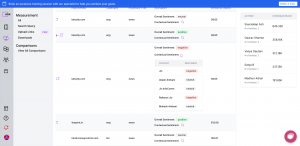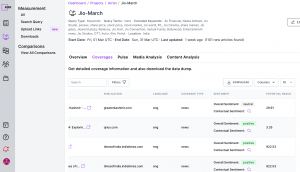Introducing Arkreach's AI-Powered Contextual Sentiment Analysis
Hey everyone, the Arkreach engineering team here!
We're thrilled to announce the launch of a revolutionary new feature – Contextual Sentiment Analysis – powered by cutting-edge AI. This innovation promises to transform the way you measure and understand public perception, giving you unparalleled insights into your communications efforts.
The Problem: Beyond Basic Sentiment Analysis
For years, we've all relied on sentiment analysis tools to gauge the overall tone of media coverage. But let's be honest, these tools often leave us wanting. They paint a broad picture, failing to capture the nuances of sentiment around specific entities within an article. This limitation can lead to misleading interpretations and hinder our ability to craft truly effective communication strategies.
Our Solution: Contextual Understanding with AI
We set out to tackle this challenge head-on. Our Contextual Sentiment Analysis goes beyond basic sentiment analysis by leveraging the power of Artificial Intelligence (AI). Here's the cool part: at the core lies a sophisticated Large Language Model (LLM) we meticulously trained on a massive dataset of 60 million articles across a whopping 50 languages.
This extensive training equips the LLM with the ability to:
- Understand Complex Language: It can handle intricate sentence structures, identify subtle sentiment cues, and distinguish between the overall tone of an article and the sentiment directed towards specific entities (think brand mentions, product names, or key spokespeople).
- Analyze Context, Not Just Keywords: Unlike traditional tools, our LLM dives deeper. It analyzes the context in which entities are mentioned, taking into account surrounding sentences, phrases, and the overall structure of the article. This contextual awareness allows it to differentiate between positive, negative, or neutral sentiment with exceptional accuracy.
Technical Deep Dive: LLM Architecture and Training
Let's delve deeper into the technical aspects of our Contextual Sentiment Analysis. Instead of building a brand new LLM from scratch, we opted for a more efficient approach. We leveraged the power of an existing, pre-trained LLM and fine-tuned it to excel at our specific task – Contextual Sentiment Analysis.
Pre-Trained Foundation: Building on Established Success
The foundation of our LLM is a pre-trained model based on the Transformer architecture, specifically a variant of the well-established BERT model. BERT has been pre-trained on a massive dataset of text and code, allowing it to learn powerful representations of language. This pre-trained model provides a strong foundation for our LLM, equipping it with a deep understanding of general language concepts and relationships.
Fine-Tuning for Contextual Sentiment Analysis:
While the pre-trained model offers a solid base, it wouldn't be sufficient for the nuanced task of Contextual Sentiment Analysis. To bridge this gap, we employed a fine-tuning process. Here's how it works:
- Tailored Training Data: We curated a massive dataset of 60 million articles specifically labelled with sentiment information at both the document and entity level. This dataset goes beyond basic sentiment labelling, allowing the LLM to learn the intricacies of sentiment directed towards specific entities within an article.
- Focused Learning: We fine-tuned the pre-trained LLM on this tailored dataset. This process essentially refines the LLM's internal parameters, allowing it to specialize in understanding sentiment within the context of news articles and identifying sentiment surrounding specific entities mentioned within those articles.
By leveraging a pre-trained model and fine-tuning it on our specialized dataset, we were able to achieve superior performance in Contextual Sentiment Analysis compared to building an LLM entirely from scratch. This approach not only saved us valuable development time but also ensured a strong foundation for our LLM's capabilities.
The rest of the blog post can continue as previously written, outlining the additional technical components, multilingual support, and future advancements. This update clarifies that Arkreach built upon an existing success (pre-trained LLM) and then customised it through fine-tuning for their specific needs.
Beyond the LLM: Additional Technical Components
While the LLM forms the core of our Contextual Sentiment Analysis, it's just one piece of the puzzle. Here are some additional technical components that contribute to the overall functionality:
- Entity Recognition and Linking: Our system employs advanced Named Entity Recognition (NER) techniques to identify and classify entities within an article. This allows the LLM to focus its analysis on these specific entities and determine the sentiment directed towards them.
- Sentiment Scoring and Classification: The LLM assigns a sentiment score to each entity, ranging from positive to negative. Additionally, it classifies the sentiment using categories like "joy," "anger," or "trust." This granular classification provides deeper insights into the nature of the sentiment.
- Data Visualization and Reporting: We've built a user-friendly interface that presents the sentiment analysis results in a clear and actionable format. This includes interactive dashboards that allow you to visualize sentiment trends over time, compare sentiment across different entities, and drill down into specific articles for further analysis.
Real-World Applications: Unlocking Strategic Advantages
This ability to pinpoint contextual sentiment unlocks a treasure trove of strategic advantages for communication professionals. Here are just a few ways you can leverage this powerful tool:
- Crisis Management: During a crisis, understanding the specific concerns and sentiment around your brand is paramount. Our Contextual Sentiment Analysis can help you identify the root cause of negativity, allowing you to address it directly and mitigate the impact of the crisis.
- Campaign Optimization: Imagine being able to identify the exact elements of your communication campaign that are striking a chord with your target audience. This level of insight is invaluable for optimizing your campaign in real-time, maximizing its effectiveness and ROI.
- Product Launch Strategies: Launching a new product requires a deep understanding of public perception. Our tool can help you identify potential concerns or negative perceptions surrounding your product, allowing you to refine your messaging and launch strategy for optimal success.
- Spokesperson Evaluation: Picking the right spokesperson is crucial. Contextual Sentiment Analysis can analyze media coverage featuring your spokesperson, providing valuable insights into their effectiveness in influencing public opinion.
Global Communication Strategies: The Power of Multilingual Support (continued)
As mentioned earlier, our Contextual Sentiment Analysis goes beyond the boundaries of a single language. To cater to the global communications landscape, we've designed our system to support a comprehensive array of languages. This includes:
- Asian Languages: Mandarin Chinese, Hindi, Japanese
- European Languages: English, French, Russian, Serbian
- Middle Eastern and North African Languages: Arabic, Persian (Farsi)
- American Languages: English, Spanish, Portuguese
- African Languages: Swahili, Amharic
Here's a technical breakdown of how we achieved multilingual support:
- Multilingual Pre-training: We pre-trained the LLM on a massive dataset of text and code that included multiple languages. This allows the LLM to learn generic language representations that can be adapted to specific languages during fine-tuning.
- Language-Specific Fine-tuning: After pre-training, we fine-tuned the LLM on datasets specifically tailored for each supported language. These datasets include sentiment-labelled articles and other relevant text data. This fine-tuning process refines the LLM's ability to understand the nuances of sentiment within each language.
- Language Detection and Processing: Our system automatically detects the language of an article and applies the appropriate pre-trained and fine-tuned LLM model for analysis. This ensures accurate sentiment analysis regardless of the source language.
Continuous Improvement: The Future of Contextual Sentiment Analysis
We understand that the field of AI and Natural Language Processing (NLP) is constantly evolving. Our team is committed to continuously improving our Contextual Sentiment Analysis tool. Here are some areas where we're focusing our efforts:
- Expanding Language Coverage: We're actively working on adding support for even more languages, ensuring our tool remains relevant for communication professionals operating on a global scale.
- Improving Accuracy and Nuance: Through ongoing research and development, we're striving to further enhance the accuracy and nuance of our sentiment analysis. This includes incorporating new techniques and leveraging advancements in the field of NLP.
- Advanced Sentiment Classification: We're exploring ways to provide more granular sentiment classifications, allowing you to gain a deeper understanding of the emotions and opinions driving public perception.
A New Era for Communications Measurement
Our Contextual Sentiment Analysis marks a significant leap forward in the field of communications measurement. By harnessing the power of AI and contextual understanding, this groundbreaking tool offers a level of precision and depth that was previously unimaginable. We're excited to see how this innovation empowers communication professionals to craft more effective strategies and achieve better results.
We encourage you to explore this new feature and see how it can transform your approach to communications measurement. As always, feel free to reach out to us with any questions. We're here to help!
Additionally, for those interested in delving deeper into the technical aspects, we'll be publishing a separate white paper that will provide a more comprehensive overview of the LLM architecture, training process, and evaluation metrics.
A Deep Dive into Our Powerful AI Modules
In the dynamic world of public relations, having the right tools can make all the difference. At Arkreach, we understand the challenges that PR professionals face daily. That's why we've developed a suite of powerful modules (supported by AI), each designed to tackle different aspects of PR work with precision and insight. From media planning to real-time sentiment analysis, our tools help you harness the power of data to drive successful outcomes. Here’s a comprehensive overview of each module and what makes them stand out.
1. Media Planning Module: In the realm of public relations, understanding and reaching your target audience is paramount. Our Media Planning Module allows you to create customized media outreach lists that are finely tuned to the demographic and psychographic traits of your audience. This module not only facilitates precise outreach but also offers predictive insights at the media category level, equipped with detailed journalist information to boost your PR efforts.
2. Measurement Module: Tracking and measuring the impact of your PR campaigns is crucial for assessing effectiveness and recalibrating strategies. The Measurement Module provides deep insights into earned media performance related to specific brands or topics. It delivers detailed, article-level data including metrics like reach, share of voice, audience persona, and sentiment—empowering you with the knowledge to make informed decisions.
3. Brand Ark (Compare): Staying ahead in competitive markets requires a clear understanding of how your brand stacks up against others. The Brand Ark Module offers real-time benchmarking for brands or topics, providing you with the insights necessary to make strategic pivots. This tool helps you navigate through complex media narratives and align your content strategy to maintain or enhance your market position.
4. Journalist Assessment Module: Building effective media relations is key to PR success. Our Journalist Assessment Module helps you identify and connect with top journalists within your media category. By analyzing the reach and impact of journalists’ articles, this tool assists in forming strategic partnerships that can amplify your media presence.
5. PULSE (AI): Keeping up with the latest trends and media interest is easier with PULSE, our AI-driven module. It curates articles based on themes relevant to your brand or sector, ensuring that you are always updated on evolving trends. This tool is invaluable for staying proactive and responsive in your communication strategies.
6. Contextual Sentiment Analysis Module: Perhaps our most groundbreaking tool, the Contextual Sentiment Analysis Module, goes beyond traditional sentiment metrics. This AI-powered feature dives deep into the sentiments associated with specific brand mentions, product names, or key figures, offering a nuanced understanding that is critical for strategic communications. With support for multiple languages and real-time analysis capabilities, it ensures that your strategies are culturally and contextually aligned no matter where in the world you are operating.
Arkreach is more than just a media monitoring tool—it's a comprehensive, full-stack communications analytics product focused on progressive metrics. Each module is designed with the unique needs of PR professionals in mind, tailored to enhance your strategic capabilities and streamline your workflow.
Stay tuned to our blog for further updates and insights into how our technology is reshaping public relations strategies around the world. Whether you’re crafting media plans, analyzing campaign performance, or adapting to fast-evolving trends, Arkreach provides the tools you need to succeed.
Arkreach’s AI Breaks New Ground in Contextual Sentiment Analysis for Comms!
We are excited to announce a groundbreaking development at Arkreach that is set to transform the landscape of communications analytics: Arkreach’s AI-powered Contextual Sentiment Analysis. Developed using a sophisticated Large Language Model (LLM) that has been custom-trained on a massive corpus of 60 million articles across 50 languages, this innovative technology is a game-changer for communication professionals worldwide.
Pinpoint Sentiment with Precision
In the fast-paced world of media, understanding the sentiment around specific entities such as brand mentions, product names, or key spokespeople is crucial. Traditional sentiment analysis tools, which only provided broad, article-level metrics, often fell short. Now, with Arkreach's advanced AI, you can drill down into the nuanced sentiments associated directly with the elements that matter most to your brand, directly through your dashboard.
Real-world Application: Consider an article discussing Jio’s endeavors in 5G rollouts, regulatory interactions with TRAI, and mentions of Mukesh Ambani. While the overall tone might skew negative, Arkreach’s Contextual Sentiment Analysis can discern and isolate the positive sentiments surrounding the 5G rollout and Mukesh Ambani’s leadership, providing a layered and precise understanding that is critical for strategic decision-making.

Empower Your Strategy with Advanced AI
This revolutionary feature doesn’t just refine sentiment analysis—it transforms it. By harnessing the power of AI, Arkreach enhances the granularity of sentiment analysis and changes how communication professionals monitor and react to public perception. The result? Sharper, more informed communications strategies backed by unprecedented accuracy.
Global Reach, Local Insight
Arkreach's AI isn't just powerful; it's also incredibly versatile. Our platform supports a comprehensive array of languages, ensuring that no matter where your communication needs lie, our technology is equipped to provide accurate, contextual insights. Here’s a breakdown of key language support by region:
- Asia:
- East Asia: Mandarin Chinese, Cantonese, Japanese, Korean, Mongolian
- South Asia: Hindi, Bengali, Punjabi, Gujarati, Marathi, Nepali, Urdu, Sinhala, Maithili, Oriya, Kannada, Malayalam, Tamil, Telugu
- Southeast Asia: Indonesian, Javanese, Vietnamese, Malay, Thai
- Central Asia: Kazakh, Kyrgyz, Uzbek, Turkmen, Azerbaijani, Pashto, Persian (Farsi)
- Europe:
- Western Europe: English, French, German, Dutch, Irish, Portuguese, Spanish, Galician, Catalan
- Northern Europe: Danish, Finnish, Swedish, Norwegian, Icelandic, Estonian, Latvian, Lithuanian
- Eastern Europe: Russian, Ukrainian, Belarusian, Polish, Czech, Slovak, Hungarian, Romanian, Bulgarian, Serbian, Croatian, Slovenian, Macedonian, Montenegrin, Bosnian, Albanian, Moldovan, Armenian, Georgian
- Middle East and North Africa:
- Arabic (across multiple countries), Hebrew, Turkish, Kurdish, Persian (Farsi), Armenian
- Americas:
- North America: English, French (Canadian), Spanish
- South America: Spanish, Portuguese (Brazilian), Quechua
- Africa:
- Sub-Saharan Africa: Swahili, Amharic, Hausa, Yoruba, Igbo, Somali
This extensive language support empowers communication teams across the globe to leverage our contextual sentiment analysis, ensuring no key insight is lost in translation. Whether you’re analyzing media from Mumbai, Moscow, or Mexico City, Arkreach provides the linguistic versatility to ensure your comms/PR strategies are culturally and contextually accurate.
Stay tuned to our blog for further updates and deep dives into how our technology is helping reshape public relations strategies around the world.
Step by Step Guide from our Knowledge base: https://arkreach.com/knowledge-base/how-to-find-contextual-sentiment-of-articles-in-arkreach/
How to Find Contextual Sentiment of Articles in Arkreach?
Understanding the nuanced sentiment around specific entities such as brand mentions or key concepts in your articles is crucial for refining your PR strategy. Follow these simple steps to utilize Arkreach’s AI-powered Contextual Sentiment Analysis within your measurement dashboard.
Step-by-Step Guide
Step 1: Create (Search/Upload) a Measurement Dashboard
- Action: Start by creating a new measurement dashboard on Arkreach. You can do this by either searching for existing data within our system or by uploading your data directly.
- Purpose: This dashboard will serve as your central platform for analyzing various media coverages and sentiments.
Step 2: Go to the Coverages Tab on the Measurement Created
- Navigation: Once your dashboard is ready, navigate to the 'Coverages' tab to view a list of articles and media pieces that mention your brand or the keywords relevant to your campaign.
- View: Here you will see a comprehensive layout of all your media coverages, neatly organized for easy analysis.

Step 3: Generate Contextual Sentiment
- Action: In the 'Sentiment' column of your coverage list, click on the magnifying glass icon.
- Result: This will generate the contextual sentiment for the specific entities like brand mentions, product names, or key individuals associated with each article.

- Note: Remember, contextual sentiment will only be generated for the brand, concept, or keywords used in creating the dashboard. This ensures that the sentiments are highly relevant and tailored to your specific aneeds.
Utilizing Arkreach’s advanced AI to analyze contextual sentiment allows you to delve deeper into the specific elements of media coverage that are most critical to your brand. This precise sentiment analysis tool helps you strategize more effectively by understanding not just the overall tone of coverage, but also the specific attitudes towards elements that are crucial to your PR efforts.
Are there any new features or updates I should be aware of?
Last updated: March 22, 2034
- Comparison: This feature enables you to compare four or more measurement dashboards for a comprehensive analysis. It assists in identifying industry benchmarks for metrics such as coverage volume, average reach, media, and content analysis.
- Pulse: This feature provides AI-curated trending themes related to your brand, any sector, or topic. Use this to stay informed about emerging trends.
- Direct Upload: Directly upload links of social media posts from influencers into the measurement dashboard. This provides a consolidated view of their analytics, along with the analytics of your uploaded news coverage links.
What kind of support is available if I face issues using Arkreach?
For any troubleshooting or demo requests, you can connect with Arkreach support via email at [email protected].
Alternatively, you can use the chat bot on the platform to talk to our experts.
Can I compare different PR campaigns or brands within Arkreach?
Yes, you can compare up to four dashboards by selecting them and hitting ‘Compare’.
After giving your comparison dashboard a name and adding it to a project, the dashboard will be ready for analysis, allowing you to pivot strategies based on insights from media and content analysis.
How do I access detailed insights from my measurement dashboard?
After uploading your media coverage or creating a dashboard, you can access detailed insights by exploring the four tabs on your dashboard: Overview, Coverages, Pulse, Media Analysis, and Content Analysis.
Each tab offers specific insights such as the number of coverages, audience engagement, article reach, and more.
What are Progressive Metrics in Arkreach?
Progressive Metrics in Arkreach focus on news consumption and behavioral data, including audience persona segments, article-level reach, share of voice, predictive media planning, sentiment analysis, journalist impact, and Ark Score. These metrics help plan PR campaigns with precise targeting and gauge the effectiveness of media coverage.
Read more about it here: https://arkreach.com/2024/02/27/understanding-new-age-progressive-pr-metrics/
How can I upload existing coverage links for measurement analysis?
To upload existing coverage links:
- Visit https://app.arkreach.com/measurement/upload.
- Name your dashboard and assign it to a project.
- Click ‘Extract Link’, add your links to clean any incompatible files, select your country, and hit ‘Upload’.




